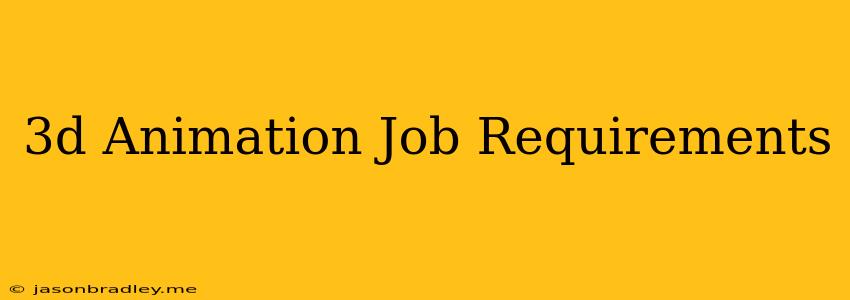3D Animation: A Career In The World Of Pixels
3D animation is a rapidly growing field with exciting opportunities for creative individuals. From blockbuster movies to video games and commercials, 3D animators bring fictional worlds to life. However, landing a job in this competitive industry requires a specific set of skills and qualifications. Here’s a breakdown of the essential requirements for a successful 3D animation career:
Technical Skills
Software Proficiency:
- 3D Modeling Software: Mastering software like Maya, 3ds Max, Blender, Cinema 4D, or ZBrush is fundamental. You'll need to create and manipulate 3D objects, from simple shapes to complex characters.
- Animation Software: Software like Maya, 3ds Max, MotionBuilder, or Houdini are essential for bringing your models to life. You'll learn to create realistic movement, expressions, and interactions.
- Rendering Software: V-Ray, Arnold, Redshift, and Octane Render are popular choices for creating high-quality images and videos.
Other Technical Skills:
- Understanding of Anatomy and Physics: Realistic animation requires knowledge of how the human body and physical laws work.
- Lighting and Texturing: Creating believable environments and characters involves understanding lighting techniques, materials, and textures.
- Compositing and Editing: You'll need to combine different elements and edit your animations to create a final product.
Artistic Skills
- Strong Visual Imagination: The ability to visualize and translate ideas into compelling visuals is crucial.
- Drawing and Sketching: A strong foundation in traditional art helps with understanding anatomy, perspective, and composition.
- Storytelling: Animators must understand the principles of storytelling to create engaging and impactful animations.
Other Requirements
- Portfolio: Showcase your best work in a professional portfolio to demonstrate your skills to potential employers.
- Communication Skills: Collaborating effectively with other artists, designers, and producers is crucial.
- Problem-Solving Skills: You'll encounter technical challenges and need to find creative solutions.
- Time Management: Meeting deadlines is vital in the fast-paced world of animation.
- Passion and Enthusiasm: A genuine passion for animation will drive your dedication and creativity.
Continuing Education
- Formal Education: A bachelor's degree in animation, computer graphics, or a related field is often preferred.
- Online Courses and Workshops: Many online platforms offer specialized courses in various animation software and techniques.
- Networking: Attending industry events, conferences, and online forums helps connect with professionals and stay updated on trends.
Career Paths
- 3D Animator: Create animated characters, objects, and environments for films, TV shows, video games, and commercials.
- VFX Artist: Create special effects for movies, TV shows, and commercials.
- Character Animator: Focus on animating characters, often for video games or animation.
- Technical Director: Lead the technical aspects of animation projects.
The world of 3D animation is constantly evolving, but with the right skills and dedication, you can carve a successful and rewarding career in this exciting industry.
